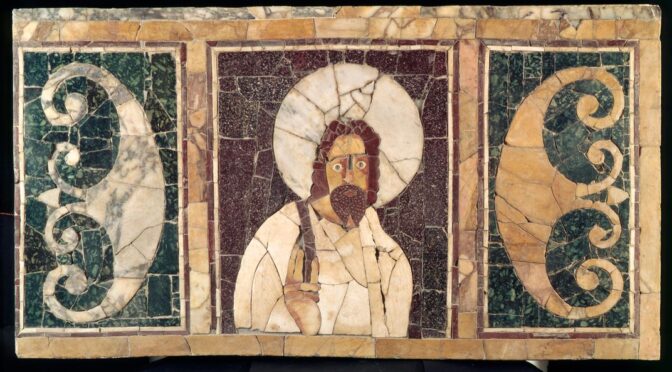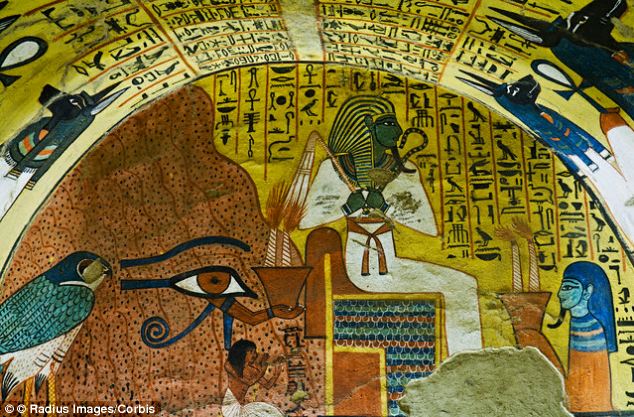Jesus image has been replicated countless times in churches and artwork, but a team of Spanish archaeologists believe they have found one of the earliest images of Jesus.
A mysterious underground room dating from between the sixth and seventh century AD holds an image of a young man with curly hair, who appears to be giving a blessing among other Coptic images.
The Catalan experts who discovered the site in the ancient Egyptian city of Oxyrhynchus think it was the final resting place for a writer and a number of priests.

A miraculous discovery! An underground room dating from the sixth century holds an image of a young man with curly hair, who appears to be giving a blessing (pictured) and one expert thinks it could be one of the earliest paintings of Jesus Christ. The image, which is seen here, has been protected from the sun with a thin layer of material
A miraculous discovery! An underground room dating from the sixth century holds an image of a young man with curly hair, who appears to be giving a blessing (pictured) and one expert thinks it could be one of the earliest paintings of Jesus Christ. The image, which is seen here, has been protected from the sun with a thin layer of material
THE UNDERGROUND ROOM
The structure dates from between the sixth and seventh century AD in the Coptic period and holds what could be an image of Jesus. It shows a young man with curly hair, dressed in a short tunic and with his hand raised as if giving a blessing
The room is thought to be a tomb for a writer and several priests, based upon artefacts found inside it, including a metallic ink well. It lies in what was the ancient city of Oxyrhynchus on a processional route between the Nile and a temple dedicated to Osiris – the ancient Egyptian god of the underworld
There is another mysterious structure closeby, linked with a flight of well-worn steps, which experts think might be another temple.
The find has been heralded as ‘exceptional’ by Josep Padró who is leading the exhibition and said the figure accompanies symbols and images of plants that are thought to date from the Coptic period of the first Christians.
Dr Padró, Emeritus Professor at the University of Barcelona, told La Vanguardia newspaper that the figure is that of ‘a young man with curly hair, dressed in a short tunic and with his hand raised as if giving a blessing.’
‘We could be dealing with a very early image of Jesus Christ.’
Archaeologists are now working to translate inscriptions surrounding the figure in the painting on the wall of the rectangular crypt in a bid to ascertain the man’s identity. The underground structure measures around eight metres long and four metres deep.
Experts from the University of Barcelona, the Catalan Egyptology Society and the University of Montpellier are also unsure of what the function of structure originally was, but said that the underground stone structure is ‘excellent’ quality.
They also found working tools of a scribe that was buried in the tomb. They include a metallic inkpot which is still full of ink and two new pens for the deceased to write during the eternal life.
Dr Padró said: ‘The archaeological site of Oxyrhynchus is known for the thousands of papyri found there, but any scribe was found to date.’
While there were no inscriptions hinting at the identity of the deceased, the remains show that the scribe was probably around 17 year’s old and lived during the Coptic Roman period.
Archaeologists and engineers had to move around 45tonnes of rock to get to the hidden artwork and another unidentified structure close by, which is connected to the tombs by a set of very worn steps is currently being investigated.

Gateway to the afterlife? The underground structure is situated in the middle of what was a processional route joining the Nile with the Osireion – the temple dedicated to Osiris – which is one of the greatest findings of Oxyrhynchus. The god is pictured in this painting in the tomb of Pashedu in Luxor, Egypt alongside – Orus, the hawk god protector of Osiris
No-one is sure of what lies inside it, but experts from the University of Barcelona think it might be a temple, perhaps dedicated to god Serapis – the Hellenistic form of Osiris who is the ancient Egyptian god of the afterlife.
The structures are situated in the middle of what was a processional route joining the Nile with the Osireion, the temple dedicated to Osiris, which is one of the greatest findings of Oxyrhynchus.
Egypt’s Minister of Antiquities, Mohamed Ibrahim, has become personally involved with the excavation, The Local reported. The Egyptian ministry will develop the archaeological site to preserve early Christian artwork.





